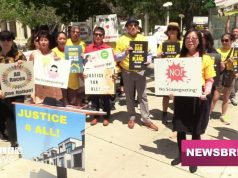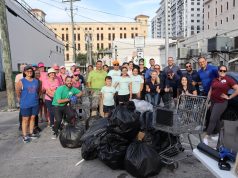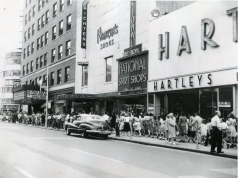Increased mobility projects – and proposals – by Amtrak, Brightline and Tri-Rail to expand accessibility throughout South Florida are placing Miami at the center of a rail renaissance.
As part of his over $2 trillion infrastructure package, President Joe Biden has called for an $85 billion investment in modernizing mass transportation, along with an additional $80 billion to expand America’s passenger and freight rail networks.
In April, the country’s leading passenger railroad corporation, Amtrak, released a map highlighting its “Connects U.S.” proposal to expand rail service across the United States over the next 15 years.
One of the proposed expansions highlighted by Amtrak includes additional rail service between Jacksonville and Miami, with stops in Orlando and Tampa.
Currently, Amtrak operates three long-distance rail lines in Florida, two of which, Silver Star and Silver Meteor, serve South Florida.
Both the Silver Meteor and Silver Star trains operate once daily between the Miami Amtrak Station and Penn Station in New York City.
Apart from Silver Star trains diverting westbound to service the cities of Lakeland and Tampa. Silver Star and Silver Meteor trains travel identical routes in Florida.
Amtrak also operates the Auto Train, a nonstop long-distance train between Lorton, Virginia, just outside Washington, and the Orlando suburb of Sanford. The Auto Train doubles as both a passenger train and a vehicle transporter.
Kimberly Woods, a public relations manager at Amtrak, said the goal for Amtrak is to grow long-distance train networks while integrating new rail connections between key Florida cities and the rest of Amtrak’s rail network.
“Our vision is to increase rail options in Florida with service from Jacksonville to Tampa, Orlando to Miami, and Tampa to Miami,” said Woods.
“We want to build upon our national network of long-distance trains, and we want to integrate new and improved corridors into our existing system that would include Florida in service to those cities around the state.”
In 2013, Amtrak was supposed to move operations from its current train station, which opened in 1978 outside Hialeah, to a newly constructed station at Miami Intermodal Center near the airport.
Miami Intermodal Center (MIC) is a multi-transportation and rental car center built to link passengers to Miami International Airport via people mover. While also providing connections to Tri-Rail, Metrorail, Metrobus, Amtrak and Greyhound Busses.
All other project components were completed and are currently in use, except for the Amtrak station.
During the initial construction of MIC, miscommunication between Amtrak and the Florida Department of Transportation resulted in a station platform that is 200 feet shorter than needed.
As a result of the error, Amtrak has not been able to use the taxpayer-funded rail station and, to this day, has continued operating out of its current station, with no foreseeable date for making a move south.
For South Florida commuters, Amtrak is one of three rail systems serving the entire tri-county region.
Regionally there is Tri-Rail, which the South Florida Regional Transportation Authority operates. Tri-Rail offers commuter rail service between Mangonia Park just north of West Palm Beach and Miami International Airport.
Accessibility to rail service is a critical element of the Miami-Dade County SMART Plan, aiming to increase mobility in and around Miami-Dade County via expansions in mass transportation through passenger rail and bus express rapid transit.
The northeast corridor component of the SMART Plan aims to link Aventura with Miami Central Station in Downtown Miami via coordination between the FDOT, Florida East Coast Railways (FEC), and Brightline.
According to Luis Espinoza, a representative for the Miami-Dade County Department of Transit and Public Works, the northeast corridor project, among other things, would reduce congestion on US 1 and I-95 by shifting single-occupancy vehicles to passenger rail and connect underserved communities along the corridor via low-cost mobility options.
“The Northeast Corridor has a high transit demand, and it provides a regional connection that links Miami-Dade County with neighbors to the north via the Florida East Coast (FEC) Railway,” said Espinoza. “The Miami Central Station development built by Brightline in downtown Miami serves as the terminus station for multiple new passenger rail services along this corridor.”
Additionally, Espinoza said that SFRTA is expanding its accessibility in the region by providing one-seat Tri-Rail rides to Miami Central Station.
However, the interest and investment in expanded rail service are not limited to the public sector.
Brightline, a privately run inter-city rail system under the operation of Florida East Coast Industries, entered the South Florida rail market in 2018, aiming to build a high-speed rail line, the first of its kind in Florida, between Miami and Orlando.
Before the pandemic, Brightline offered daily passenger rail service at speeds of up to 79 mph between Miami, Fort Lauderdale and West Palm Beach.
Brightline’s plan to link South Florida to Central Florida is under construction and expected to be completed in 2022, whisking passengers between both regions in under three hours at speeds of 125 mph.
Brightline is also working with the FDOT on a potential expansion to the Disney Springs section of the Walt Disney World Resort and the City of Tampa.
Per Brightline’s website, “Brightline is designed to reinvent travel and take cars off the road by connecting city pairs and congested corridors that are too close to fly and too long to drive.”
Calls to representatives at Brightline were not returned. However, back in March, the company issued a press release announcing Christine Kefauver as Brightline’s new senior vice president of corporate development.
Kefauver is known in Central Florida for her seven years as a transportation policy advisor for the City of Orlando. Her efforts were a contributor to advancing SunRail, the first commuter rail line in Central Florida.
“The transportation industry is changing rapidly, and there is no better example than Brightline’s effort to connect Florida with high-speed rail,” she said in the release. “I’m excited to jump on board and look forward to building a transportation system and network that will accelerate Central Florida’s mobility plans and continue to make Florida our nation’s most competitive state.”
































